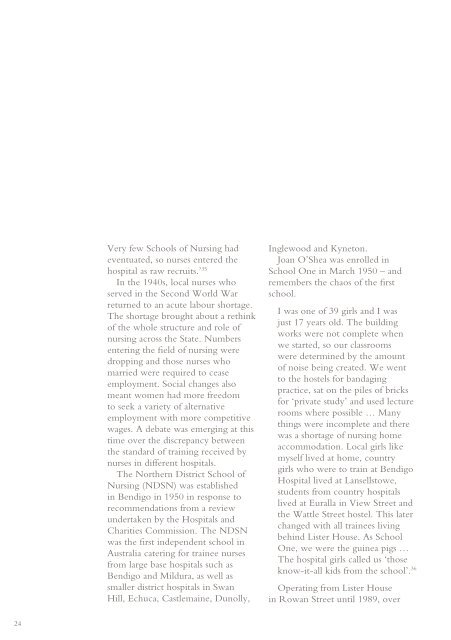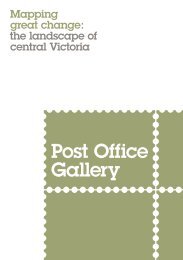A cure for all ills: medicine in Bendigo
This electronic publication accompanies the exhibition A cure for all ills: medicine in Bendigo. From chaotic beginnings to the formation of professional practice, the introduction of regulations against quackery and the establishment of long standing institutions such as Bendigo Hospital, A cure for all ills: medicine in Bendigo explored the social history surrounding the foundations of healthcare in Bendigo and the contribution of doctors, pharmacists, dentists, nurses and Chinese herbalists in providing essential health services to the community.
This electronic publication accompanies the exhibition A cure for all ills: medicine in Bendigo.
From chaotic beginnings to the formation of professional practice, the introduction of regulations against quackery and the establishment of long standing institutions such as Bendigo Hospital, A cure for all ills: medicine in Bendigo explored the social history surrounding the foundations of healthcare in Bendigo and the contribution of doctors, pharmacists, dentists, nurses and Chinese herbalists in providing essential health services to the community.
You also want an ePaper? Increase the reach of your titles
YUMPU automatically turns print PDFs into web optimized ePapers that Google loves.
Very few Schools of Nurs<strong>in</strong>g had<br />
eventuated, so nurses entered the<br />
hospital as raw recruits.’ 35<br />
In the 1940s, local nurses who<br />
served <strong>in</strong> the Second World War<br />
returned to an acute labour shortage.<br />
The shortage brought about a reth<strong>in</strong>k<br />
of the whole structure and role of<br />
nurs<strong>in</strong>g across the State. Numbers<br />
enter<strong>in</strong>g the field of nurs<strong>in</strong>g were<br />
dropp<strong>in</strong>g and those nurses who<br />
married were required to cease<br />
employment. Social changes also<br />
meant women had more freedom<br />
to seek a variety of alternative<br />
employment with more competitive<br />
wages. A debate was emerg<strong>in</strong>g at this<br />
time over the discrepancy between<br />
the standard of tra<strong>in</strong><strong>in</strong>g received by<br />
nurses <strong>in</strong> different hospitals.<br />
The Northern District School of<br />
Nurs<strong>in</strong>g (NDSN) was established<br />
<strong>in</strong> <strong>Bendigo</strong> <strong>in</strong> 1950 <strong>in</strong> response to<br />
recommendations from a review<br />
undertaken by the Hospitals and<br />
Charities Commission. The NDSN<br />
was the first <strong>in</strong>dependent school <strong>in</strong><br />
Australia cater<strong>in</strong>g <strong>for</strong> tra<strong>in</strong>ee nurses<br />
from large base hospitals such as<br />
<strong>Bendigo</strong> and Mildura, as well as<br />
sm<strong>all</strong>er district hospitals <strong>in</strong> Swan<br />
Hill, Echuca, Castlema<strong>in</strong>e, Dunolly,<br />
Inglewood and Kyneton.<br />
Joan O’Shea was enrolled <strong>in</strong><br />
School One <strong>in</strong> March 1950 – and<br />
remembers the chaos of the first<br />
school.<br />
I was one of 39 girls and I was<br />
just 17 years old. The build<strong>in</strong>g<br />
works were not complete when<br />
we started, so our classrooms<br />
were determ<strong>in</strong>ed by the amount<br />
of noise be<strong>in</strong>g created. We went<br />
to the hostels <strong>for</strong> bandag<strong>in</strong>g<br />
practice, sat on the piles of bricks<br />
<strong>for</strong> ‘private study’ and used lecture<br />
rooms where possible … Many<br />
th<strong>in</strong>gs were <strong>in</strong>complete and there<br />
was a shortage of nurs<strong>in</strong>g home<br />
accommodation. Local girls like<br />
myself lived at home, country<br />
girls who were to tra<strong>in</strong> at <strong>Bendigo</strong><br />
Hospital lived at Lansellstowe,<br />
students from country hospitals<br />
lived at Eur<strong>all</strong>a <strong>in</strong> View Street and<br />
the Wattle Street hostel. This later<br />
changed with <strong>all</strong> tra<strong>in</strong>ees liv<strong>in</strong>g<br />
beh<strong>in</strong>d Lister House. As School<br />
One, we were the gu<strong>in</strong>ea pigs …<br />
The hospital girls c<strong>all</strong>ed us ‘those<br />
know-it-<strong>all</strong> kids from the school’. 36<br />
Operat<strong>in</strong>g from Lister House<br />
<strong>in</strong> Rowan Street until 1989, over<br />
Northern District School<br />
of Nurs<strong>in</strong>g School One<br />
1950<br />
gelat<strong>in</strong> silver pr<strong>in</strong>t<br />
Collection Northern<br />
District School of<br />
Nurs<strong>in</strong>g Graduates<br />
Association<br />
3,000 students <strong>in</strong> 108 Schools were<br />
educated to be tra<strong>in</strong>ed nurses through<br />
the NDSN. 37 Each school provided<br />
a theoretical <strong>in</strong>struction program<br />
by way of structured study blocks.<br />
Follow<strong>in</strong>g this, the student nurses<br />
returned to their tra<strong>in</strong><strong>in</strong>g hospitals<br />
to work <strong>in</strong> designated areas to ga<strong>in</strong><br />
appropriate cl<strong>in</strong>ical experience. On<br />
successfully complet<strong>in</strong>g three years<br />
of tra<strong>in</strong><strong>in</strong>g, students passed out as<br />
graduates of their specific tra<strong>in</strong><strong>in</strong>g<br />
hospital. The exceptions to this were<br />
the Pilot Groups who were students<br />
of the School and became Graduates<br />
of the Northern District School of<br />
Nurs<strong>in</strong>g. This method of tra<strong>in</strong><strong>in</strong>g was<br />
the <strong>for</strong>erunner to today’s tertiarybased<br />
nurses’ education.<br />
Evolution<br />
The <strong>Bendigo</strong> goldfields grew at a<br />
rapid pace with thousands descend<strong>in</strong>g<br />
upon the region <strong>in</strong> less than a year<br />
of gold be<strong>in</strong>g discovered. In this<br />
context, structures <strong>for</strong> the provision<br />
of healthcare <strong>in</strong>evitably evolved <strong>in</strong><br />
an ad hoc fashion, develop<strong>in</strong>g more<br />
from urgent need and <strong>in</strong>dividual<br />
entrepreneurship than systematic<br />
plann<strong>in</strong>g. Regulatory bodies<br />
played catch-up, endeavour<strong>in</strong>g to<br />
make sense of a makeshift system<br />
of overlapp<strong>in</strong>g discipl<strong>in</strong>es and the<br />
<strong>in</strong>filtration of quackery. Along with<br />
regulation, many technical, scientific<br />
and educational advancements<br />
have taken place <strong>in</strong> the 160 years<br />
s<strong>in</strong>ce healthcare <strong>for</strong>m<strong>all</strong>y began <strong>in</strong><br />
<strong>Bendigo</strong> and early chaos has given<br />
way to a sophisticated system <strong>for</strong><br />
the provision of essential services to<br />
the community. Through diligent<br />
campaign<strong>in</strong>g, generous community<br />
support and the hard work of<br />
dedicated health professionals, this<br />
system has expanded to become a<br />
major <strong>in</strong>dustry, which <strong>in</strong>cludes the<br />
<strong>Bendigo</strong> Hospital soon to become<br />
one of Australia’s largest regional<br />
hospitals.<br />
Clare Needham<br />
Curator, City History<br />
and CollectioNS<br />
24 25

















